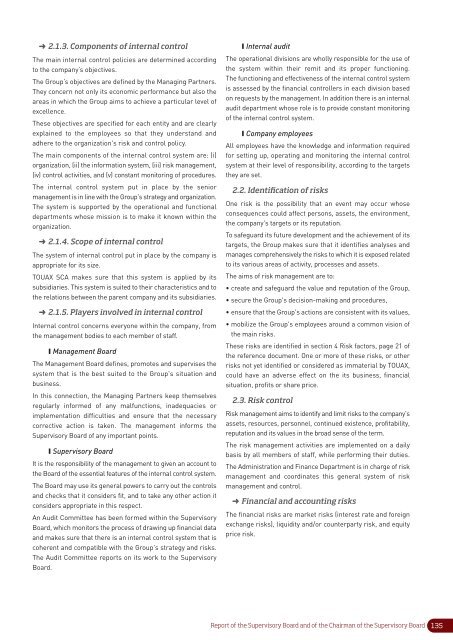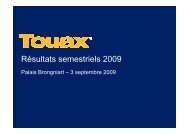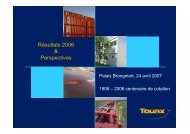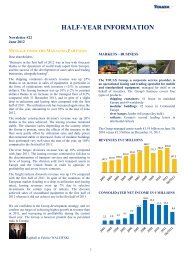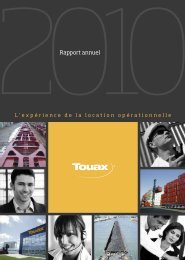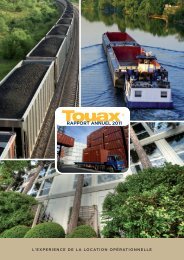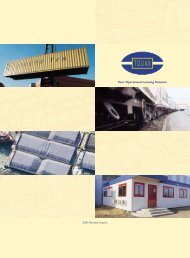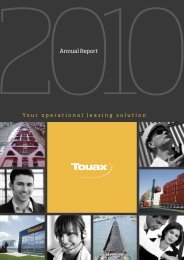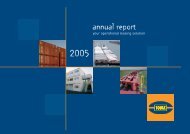2011 Annual report - touax group
2011 Annual report - touax group
2011 Annual report - touax group
You also want an ePaper? Increase the reach of your titles
YUMPU automatically turns print PDFs into web optimized ePapers that Google loves.
➜ 2.1.3. Components of internal control<br />
The main internal control policies are determined according<br />
to the company’s objectives.<br />
The Group’s objectives are defined by the Managing Partners.<br />
They concern not only its economic performance but also the<br />
areas in which the Group aims to achieve a particular level of<br />
excellence.<br />
These objectives are specified for each entity and are clearly<br />
explained to the employees so that they understand and<br />
adhere to the organization's risk and control policy.<br />
The main components of the internal control system are: (i)<br />
organization, (ii) the information system, (iii) risk management,<br />
(iv) control activities, and (v) constant monitoring of procedures.<br />
The internal control system put in place by the senior<br />
management is in line with the Group's strategy and organization.<br />
The system is supported by the operational and functional<br />
departments whose mission is to make it known within the<br />
organization.<br />
➜ 2.1.4. Scope of internal control<br />
The system of internal control put in place by the company is<br />
appropriate for its size.<br />
TOUAX SCA makes sure that this system is applied by its<br />
subsidiaries. This system is suited to their characteristics and to<br />
the relations between the parent company and its subsidiaries.<br />
➜ 2.1.5. Players involved in internal control<br />
Internal control concerns everyone within the company, from<br />
the management bodies to each member of staff.<br />
❙ Management Board<br />
The Management Board defines, promotes and supervises the<br />
system that is the best suited to the Group's situation and<br />
business.<br />
In this connection, the Managing Partners keep themselves<br />
regularly informed of any malfunctions, inadequacies or<br />
implementation difficulties and ensure that the necessary<br />
corrective action is taken. The management informs the<br />
Supervisory Board of any important points.<br />
❙ Supervisory Board<br />
It is the responsibility of the management to given an account to<br />
the Board of the essential features of the internal control system.<br />
The Board may use its general powers to carry out the controls<br />
and checks that it considers fit, and to take any other action it<br />
considers appropriate in this respect.<br />
An Audit Committee has been formed within the Supervisory<br />
Board, which monitors the process of drawing up financial data<br />
and makes sure that there is an internal control system that is<br />
coherent and compatible with the Group's strategy and risks.<br />
The Audit Committee <strong>report</strong>s on its work to the Supervisory<br />
Board.<br />
❙ Internal audit<br />
The operational divisions are wholly responsible for the use of<br />
the system within their remit and its proper functioning.<br />
The functioning and effectiveness of the internal control system<br />
is assessed by the financial controllers in each division based<br />
on requests by the management. In addition there is an internal<br />
audit department whose role is to provide constant monitoring<br />
of the internal control system.<br />
❙ Company employees<br />
All employees have the knowledge and information required<br />
for setting up, operating and monitoring the internal control<br />
system at their level of responsibility, according to the targets<br />
they are set.<br />
2.2. Identification of risks<br />
One risk is the possibility that an event may occur whose<br />
consequences could affect persons, assets, the environment,<br />
the company's targets or its reputation.<br />
To safeguard its future development and the achievement of its<br />
targets, the Group makes sure that it identifies analyses and<br />
manages comprehensively the risks to which it is exposed related<br />
to its various areas of activity, processes and assets.<br />
The aims of risk management are to:<br />
• create and safeguard the value and reputation of the Group,<br />
• secure the Group's decision-making and procedures,<br />
• ensure that the Group's actions are consistent with its values,<br />
• mobilize the Group's employees around a common vision of<br />
the main risks.<br />
These risks are identified in section 4 Risk factors, page 21 of<br />
the reference document. One or more of these risks, or other<br />
risks not yet identified or considered as immaterial by TOUAX,<br />
could have an adverse effect on the its business, financial<br />
situation, profits or share price.<br />
2.3. Risk control<br />
Risk management aims to identify and limit risks to the company's<br />
assets, resources, personnel, continued existence, profitability,<br />
reputation and its values in the broad sense of the term.<br />
The risk management activities are implemented on a daily<br />
basis by all members of staff, while performing their duties.<br />
The Administration and Finance Department is in charge of risk<br />
management and coordinates this general system of risk<br />
management and control.<br />
➜ Financial and accounting risks<br />
The financial risks are market risks (interest rate and foreign<br />
exchange risks), liquidity and/or counterparty risk, and equity<br />
price risk.<br />
Report of the Supervisory Board and of the Chairman of the Supervisory Board 135


